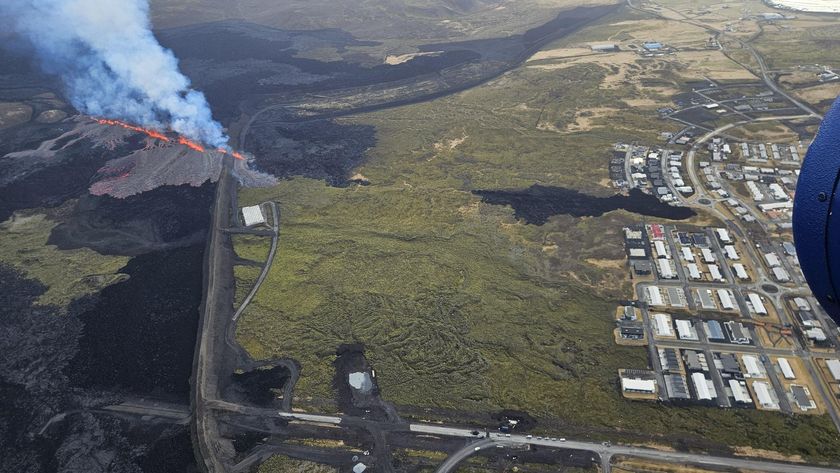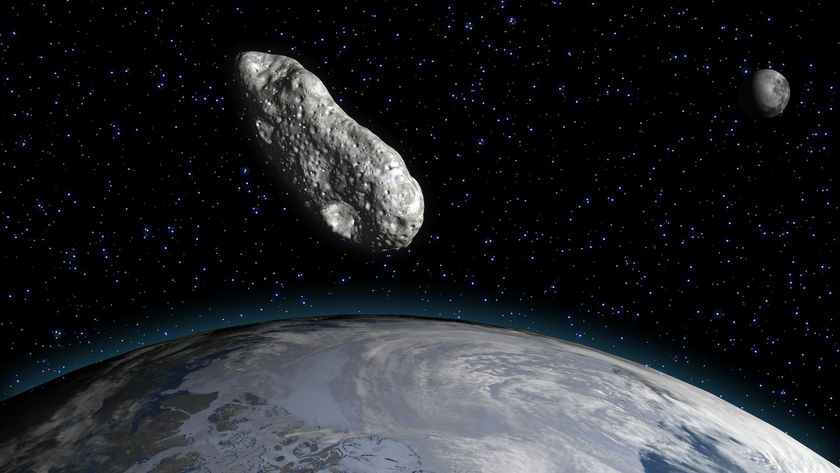Dinosaur-Killing Asteroid Triggered Mile-High Tsunami That Spread Through Earth's Oceans

When the dinosaur-killing asteroid collided with Earth more than 65 million years ago, it did not go gently into that good night. Rather, it blasted a nearly mile-high tsunami through the Gulf of Mexico that caused chaos throughout the world's oceans, new research finds.
The 9-mile-across (14 kilometers) space rock, known as the Chicxulub asteroid, caused so much destruction, it's no wonder the asteroid ended the dinosaur age, leading to the so-called Cretaceous-Paleogene (K-Pg) extinction.
"The Chicxulub asteroid resulted in a huge global tsunami, the likes of which have not been seen in modern history," said lead researcher Molly Range, who did the research while getting her master's degree in the Department of Earth and Environmental Sciences at the University of Michigan. [Image Gallery: Ancient Monsters of the Sea]
Range and her colleagues presented the research, which has yet to be published in a peer-reviewed journal, at the American Geophysical Union's annual meeting on Dec. 14 in Washington, D.C. And the research, first reported by EOS, is novel. "As far as we know, we are the first to globally model the tsunami from impact to the end of wave propagation," Range told Live Science.
The idea for the project got started when Range's two advisors — Ted Moore and Brian Arbic, both in the Department of Earth and Environmental Sciences at the University of Michigan — realized there was a glaring gap in the Chicxulub research field. Mainly, no one had published a global simulation of the tsunami the asteroid created.
"It wasn’t until starting this project that I realized the actual scale of this tsunami, and it’s been a fun research story to share," Range said.
Getting to work
The researchers knew that the asteroid hit shallow water in the Gulf of Mexico. But to correctly model its huge impact, they needed a model that could compute "the large scale deformation of the [Earth’s] crust that formed the crater, as well as the chaotic waves from the initial blast of water away from the impact site, and waves from ejecta falling back into the water," Range said. So, the group turned to Brandon Johnson, an assistant professor who studies impact cratering at Brown University in Rhode Island.
Sign up for the Live Science daily newsletter now
Get the world’s most fascinating discoveries delivered straight to your inbox.
Johnson ran a model detailing what happened in the 10 minutes following the impact, when the crater was nearly a mile deep (1.5 kilometers) and the blast was so powerful, there wasn't any water in the crater yet. "At this point, some water was moving back toward the crater," Range said. According to the model, "this water will then rush into the crater and then back out, forming the 'collapse wave.'"
In a second model, the team studied how the tsunami propagated through oceans around the world. They did this by taking the results from the first model (particularly the crater shape) and the impact's waves with respect to resting sea level and water speeds, Range said. They then used data sets on the ancient terrain of the ocean, and used that to determine how the tsunami would have played out.
The results show the effects of the tsunami were felt all around the world. [In Pictures: Japan Earthquake & Tsunami]
"We found that this tsunami moved throughout the entire ocean, in every ocean basin," Range said. In the Gulf of Mexico, water moved as fast as 89 mph (143 km/h), she found. Within the first 24 hours, the effects of the tsunami's impact spread out of the Gulf of Mexico and into the Atlantic, as well as through the Central American seaway (which doesn't exist anymore, but used to connect the Gulf to the Pacific).
After the initial nearly mile-high (1.5 km) wave, other huge waves rocked the world's oceans. In the South Pacific and North Atlantic, waves reached a whopping maximum height of 46 feet (14 m). In the North Pacific, they reached 13 feet (4 m). Meanwhile, the Gulf of Mexico saw waves as high as 65 feet (20 meters) in some spots and 328 feet (100 m) in others.
To put that in perspective, the largest modern wave ever recorded in the Southern Hemisphere was a "measly" 78 feet (23.8 m) tall, which struck near New Zealand in May 2018, Live Science previously reported.
Hard evidence
There's evidence that supports the models, Range said. According to the second model, fast-moving water from the impact likely caused erosion and sediment disruption in South Pacific, North Atlantic and Mediterranean ocean basins.
In a separate study (which also has yet to be published), Moore examined sediment records across the ocean. His findings agree with the tsunami model, Range said.
It can be hard to imagine such a cataclysmic tsunami, so the researchers compared it to the 2004 Indian Ocean tsunami that killed at least 225,000 people. The two tsunamis were as different as night and day, they found. "Over the first 7 hours of both tsunamis, the [Chicxulub] impact tsunami was 2,500 to 29,000 times greater in energy than the 2004 Indian Ocean tsunami," Range said.
Of course, the giant tsunami wasn't the only event that did in the non-avian dinosaurs. The asteroid also triggered shock waves and sent a vast amount of hot rock and dust into the atmosphere, which rubbed together with so much friction that they started forest fires and cooked animals alive. These particles also hovered in the atmosphere and blocked the sun's rays for years, killing plants and the animals that ate them.
- Crash! 10 Biggest Impact Craters on Earth
- Photos: The World's Weirdest Geological Formations
- In Photos: The UK's Geologic Wonders
Originally published on Live Science.

Laura is the archaeology and Life's Little Mysteries editor at Live Science. She also reports on general science, including paleontology. Her work has appeared in The New York Times, Scholastic, Popular Science and Spectrum, a site on autism research. She has won multiple awards from the Society of Professional Journalists and the Washington Newspaper Publishers Association for her reporting at a weekly newspaper near Seattle. Laura holds a bachelor's degree in English literature and psychology from Washington University in St. Louis and a master's degree in science writing from NYU.










